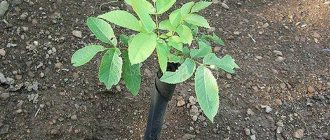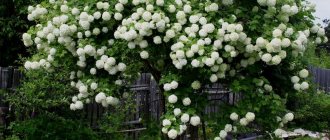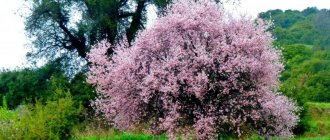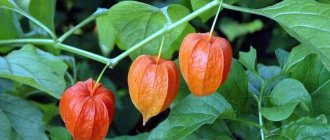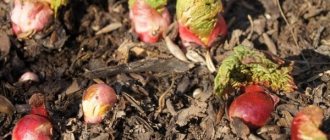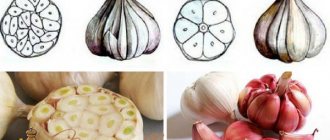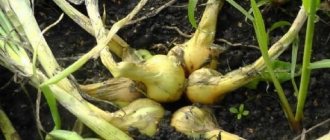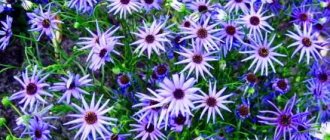Hazelnut is a garden form of hazelnut.
This is a compact shrub plant with dark green foliage and nuts, reaching a height of up to 3 m. The culture is unpretentious and will take root very well in a summer cottage. It is grown even in northern latitudes, since some varieties of trees can withstand temperatures down to -50˚C. Hazelnuts begin to bear fruit after 4-6 years.
The Slavs are very superstitious people. Since ancient times, there has been such a belief that if during a thunderstorm you hide under a hazel tree in the forest or tuck several hazel twigs into your belt, then lightning will bypass this place. And people firmly believed that hazel twigs could scare away evil spirits. They carried a small twig with them to ward off evil spirits and drive away snakes in the forest. They also laid out hazel branches in barns where grain reserves were stored for the winter - mice do not like this tree and try to avoid it. Therefore, there were never mice in the granaries, which means the supplies were completely safe.
The Southern Slavs have this belief: if you go into the forest on the Christian holiday of Trinity and find a hazel tree, you can try to communicate with the spirits of deceased relatives who descend from heaven on this day along the thin branches of the hazel tree, and then return in the same way.
This tree belongs to the birch family. The plant lives in coniferous and mixed forests. Small shrubs are most common. The hazel leaves are round and large, the shape is interesting, reminiscent of the body of a bream fish. The flowers of this plant are unisexual; the male flowers are thick catkins that grow on short branches. They develop in the autumn and calmly endure the winter so that with the onset of warmth they have time to bloom even before the first leaves appear. Female flowers can be distinguished from male flowers by this feature: they are collected by buds and “sit” in pairs in bracts (in their axils). Female flowers can also be distinguished by their underdeveloped perianth and lower ovary with one ovule in each nest. Due to the fact that one testicle does not develop, it turns out that the fruit is a woody pericarp, or nut. Each nut is “dressed” in a plus (a small “skirt” or incised cover), which originates from the pre-leaves of female flowers.
The hazel flowering period is early March. At this time, inflorescences are actively forming, and pollen is carried by the wind.
In our region, summer residents have actively begun to grow hazel. The flowering period is much later due to climate conditions.
Hazelnut varieties
Early Trebizond . You can harvest from tall bushes by the end of July. The nuts are large, oval, with a slightly pointed nose. They are easy to clean because the fruits are covered with a thin shell.
Cosford . Nuts are collected from the tree from mid-August. The fruits are large, oblong in shape. The variety is notable for being resistant to common diseases and pest attacks.
Warsaw red . A shrub with red leaves, forms a spherical shape. Gardeners grow this variety not only to produce hazelnuts, but also to decorate the garden. The fruits are large and tasty.
Almond-shaped . The variety got its name because of its unusual taste - the seeds have an almond flavor. The fruits are medium in size, with a thin shell. Trees, when growing conditions are met, produce high yields.
Barcelona. The plant develops a dense, heavily leafy crown. Under favorable conditions it can grow up to 5 m in height. Hazelnuts of this variety tolerate cold well. The nuts are very large, slightly flattened. The fruit kernels are tasty, juicy, covered with a thin shell. Gardeners begin harvesting in early September. The main disadvantage of the Barcelona variety is its vulnerability to moniliosis.
Roman . The variety is famous for its large nuts, which begin to ripen by August. The plant is resistant to diseases and pests.
Halle. The tree grows densely leafy. The nuts are cone-shaped, large, with a thick shell. This hazelnut variety is more suitable for growing in the southern regions, since the fruits ripen only towards the end of September. Galle is considered the most prolific variety of all.
Walnut: cultivars and varieties
In Russia, walnuts, brought by traders from Greece, have been cultivated for more than 1000 years.
The crop is highly valued for its healthy and tasty nuts, valuable wood and leaves, which are used to prepare medicinal potions. The nut is usually cultivated in the southern regions; in central Russia, the crop often freezes out in cold winters, sometimes the plant does not even reach fruiting age.
Walnut is one of the most popular types of nuts in our country.
Breeders are carrying out targeted work to create walnut varieties that are ideal for cold winters and suitable for successful cultivation in the middle zone and the Moscow region.
The photo shows varieties of walnuts recommended for growing in the Moscow region:
“Sadko” is a dwarf variety that tolerates frosty winters well without frostbite of the trunk and crown. The variety grows steadily, bears fruit abundantly, bearing thin-barked and large nuts. The tree enters the fruiting phase in the 3rd year, its height is from 4 to 5 meters.
Variety "Sadko"
“Ideal” - the popularity of this variety among gardeners is very high, which is due to the tree’s high resistance to frost and early fruiting - the nut can withstand winter temperatures down to -35 degrees, and begins to bear fruit from the 2nd year of life. For normal development, the tree needs space and sunlight. It is not recommended to plant the “Ideal” variety near existing buildings - the powerful root system can damage the foundation of the building. The “Ideal” nut reaches a height of up to 5 meters. Bears fruit 2 times a year.
Variety "Ideal"
“Podmoskovye” - the variety is characterized by frost resistance and an early harvest of large nuts.
Variety "Moscow region"
“Giant” - a variety similar to “Ideal”, but begins to bear fruit at 5-6 years of age. From one tree you can collect up to one hundredweight of nuts.
Variety "Giant"
- “Harvest” is a winter-hardy tree, resistant to disease, reaches a height of 6 m. It enters the fruiting phase in the 4th year. A bountiful harvest can be harvested in the second half of September. The average nut yield from one tree is approximately 25 kg.
- More recently, breeders have developed a new walnut variety, Astakhovsky, which is characterized by high winter hardiness and resistance to pests and diseases. The crown of the tree recovers well after freezing; the plant can withstand winter temperatures down to -37 degrees. The fruits of the new variety are larger than those of the “Ideal” variety. Fruiting occurs in the 6th year.
Features of growing hazelnuts
Hazelnuts, being a forest plant, prefer warm, sunny places well protected from strong winds. Select an area near the southwestern or western wall of the house to grow a tree.
If this is not possible, then hedges can provide protection from drafts. But make sure that the plants are located no closer to the hazelnuts than 4-5 m. Otherwise, the root system will lack nutrients. Hazelnuts do not like frequently flooded lands - grow them where a lot of moisture does not accumulate in the spring. Groundwater should lie no closer than 1.5 m to the ground surface.
Immediately before planting, remove the weeds and dig up the area (one and a half bayonets). Apply fertilizers to the upper layers of the soil for better survival of seedlings - 50 g of potassium salt and 200 g of superphosphate. The dimensions of the planting holes are 60*50 cm.
The best time to plant hazelnuts is the beginning of October. Since the tree has a very short dormant period, many seedlings do not take root in the spring. If you missed the deadline, then carry out spring planting in April-May.
Place the seedling in the hole so that the trunk of the tree is buried 3-4 cm deeper into the ground than it was planted in the nursery. In this case, the root collar should not be covered with soil. The roots in the hole must be carefully straightened and covered with loose soil. After planting the plant, the tree trunk circle is watered abundantly - 20-25 liters of water. And when the moisture is absorbed into the soil, mulch the ground using sawdust, bark, wood chips or peat. Trim the planted plant to 5-6 buds.
Photos from open sources on the Internet
If you plant several specimens, then follow a certain pattern:
- distance between rows – 5-6 m,
- the distance between plants is 4-4.5 m.
Despite the fact that hazelnuts do not like waterlogging, they respond well to abundant, timely watering . This is especially important in dry summers - the plant may die. Depending on the weather, hazelnuts are moistened 1-2 times a month.
In July, regularly check whether the soil around the trunk has dried out - during this period, many varieties begin to actively grow fruits that need an abundance of nutrients.
When fertilizing hazelnuts, if they grow on soil rich in microelements, you need to use a minimum of nitrogen fertilizers. In this case, the green mass grows abundantly, but the yield decreases. Organic matter, such as slurry, is mainly used as a source of nutrients. Before the growing season begins, the nut will need potassium and phosphorus. When the ovaries begin to grow, hazelnuts can be fertilized with 0.5% urea. During the fruiting period, add 1-2 buckets of humus (with the addition of 100 g of nitroammophoska) to the tree trunk circles. Already in the fall, feed the tree with wood ash.
Where to plant walnuts on the plot
Proper planting of walnuts is the key to high yields and longevity of the tree. The culture takes up a lot of space, and in adulthood it does not like transplants. If we add here the allelopathic nature of the walnut, it becomes clear that the wrong location of the tree can cause a lot of problems.
The culture occupies an intermediate position between shade-tolerant and sun-loving plants. At a young age, the seedling is quite shade-tolerant. When it grows and begins to bear fruit, the yield and further development of the tree depend on the illumination of the crown.
The walnut root system is adapted to many types of soil:
- on chernozems, an adult tree generally grows without fertilizing;
- walnut develops well on alkaline, lime-rich soils, loose fertile loams and sandy loams;
- it will grow on calcareous-crushed, stony-sandy, rocky soils if they are well moistened and permeable;
- on dense, poor soils the tree forms a small crown, grows poorly and produces little fruit;
- Podzolic, acidic, soaking, cold soils inhibit development and often cause freezing and death of the seedling.
Only highly saline, swampy and dense wet clay soils are completely unsuitable for growing walnuts.
The tree will reach its maximum height and will produce the greatest yields if the groundwater level is no closer than 2.3 m from the surface. But the walnut is a unique, flexible crop. With higher aquifers, it simply will not grow to 25 m.
Since the walnut is often the tallest tree in the garden, it should be planted on the northern or western edge so as not to shade other crops. The place should be sunny and sheltered from the wind. Once the tree grows, it will be impossible to protect it, but this will no longer be critical.
Important! It should also be taken into account that other crops grow poorly next to the nut.
Hazelnut diseases and pests
The most common hazelnut disease that many gardeners have to deal with is powdery mildew . This is a fungus that attacks leaves and shoots. They are covered with a grayish sticky coating. Later, black spots appear on the mold. The bad thing is that the fungus can easily survive the winter and then return to the plant. If you find traces of powdery mildew on the foliage, remove the damaged parts of the plant and burn them. Hazelnuts can be sprayed several times with a 10-day break with a 2% solution of lime-sulfur decoction.
Nut weevil . Female insects chew through the nuts - they can no longer be eaten. You can free hazelnuts from the nut weevil by deep digging around the tree trunk, since the larvae and adults live in the soil. Spraying with special means will help.
Walnut longhorned beetle . The bug infects the shoots of the plant, which affects the yield reduction. Damaged branches die off completely over time. Cut off and burn the affected stems, treat the plant with special solutions.
Achievements of our siblings in nut growing
lusien2005
I have a huge Manchurian nut, it’s about 40 years old, every year the uncollected nuts that fall to the ground sprout, and over the summer a small tree grows, 50 cm tall. I dig them up and distribute them, including planting them in different places on my site and at my mother’s. By the age of 5, this tree is already 1.60-1.80 tall, if you don’t trim it. I don’t do anything with them, I just water them along with other bushes and trees. My nut is 15 meters high. But it can be shaped by cutting. Place the nuts on the ground, lightly cover them with soil now, they will sprout in the spring. The nuts are edible, taste like walnuts, but the shell is difficult to crack, very strong. It's medicinal. almost all parts. Releases iodine. It’s useful to just stand under it and breathe.
Small nut. photo Mishal
Young nut. photo nati910
Kira81
And we bought a plot of Manchurian walnut. The tree is big. Grows next to spruce. There is a gorgeous lawn under the tree, and there are also raspberries and honeysuckle. I don’t know how fruitful they are, though. But I am very pleased that I got such a nut. Although it is very difficult to get nuts from the shell. And I wouldn’t say that nuts are smaller than walnuts. The sizes are the same. In terms of weight, of course, Manchurian is heavier, but there is less pulp than walnut.
Hope
I have a Manchurian nut growing, one tree, for more than 10 years, a beautiful spreading tree has grown, we rest under it, but, as they say, “we haven’t seen milk yet.” Every spring I have long earrings on it, like a birch tree.
Irimurus
An easy way to crack a Manchurian nut: on a baking sheet and in the oven, at 200 degrees, for 5-7 minutes, the nut itself bursts into halves, we eat the pulp, the shell is used for children’s crafts.
On Sakhalin, by the way, they grow as tall as a five-story building.
Melifaro
They are growing from five-story buildings in Omsk too. Only now, even my lilies, which fell into the zone of its crown as it grew, looked depressed this year and were drawn towards the sun from it.
a12321a
The heart-shaped one looks almost the same as the Manchurian, however, my Manchurian is tall, slender, and the heart-shaped one is like an apple tree, due to the fact that the growth buds froze every year.
Squirrels love Manchurian nuts too!
Photo of nut One, Two, Three
Walnuts have many beneficial properties. Its peculiarity is that there are varieties that gardeners grow even in harsh climatic conditions. This article will focus on growing walnuts in Siberia.
Sibmothers also grow hazelnuts
S-Anka's story
I have hazel growing. Two varietal bushes (green and red) and an ordinary one, from nuts that sprouted last year in the spring. The growth of varietal varieties is good, but the green one grows upward, while the red one somehow grows wider.
Here are my first years:
And here are the leaves of the red leaf:
I took nuts for planting from a neighbor. That year, before winter, I put a handful in the grass, went and looked at it on the weekend, and the nuts hatched. Here's the beauty next door:
Photos open in large size when you click on the picture
To date, several seedlings have sprouted. I’ll tell you straight - the germination percentage is very small. But they grew better than last year.
In general, if not for nuts (I’m not sure it will bear fruit. But at least it should work as a pollinator), I recommend the red-leaved variety. It’s very beautiful, even though it grows clumsily for me.
She picked catkins from one plant and shook them over the flower buds of another. I don’t know, maybe one will bear a little fruit, but in general you need at least two bushes.
Photos open in large size when you click on the picture
And now I have the first nuts on red-leaved hazelnuts!
Here are hazelnut leaves for comparison. In the center the hazel is not varietal.
The nuts are also different. The varietal leaves next to the nut are long, while the ordinary ones are short, and the nut is clearly visible.
Photos open in large size when you click on the picture
Story Onli You
The discovery of this summer season for me was a hazelnut bush. More like a tree, though. It grew in the shade and was closely surrounded by cherry trees. Moreover, based on its leaves, I took it for a linden tree.
And now... in the middle of summer. Nuts were accidentally discovered on that *linden tree!
